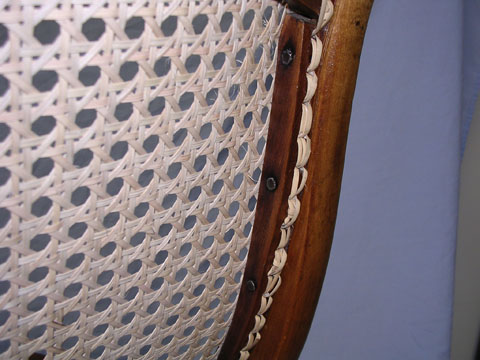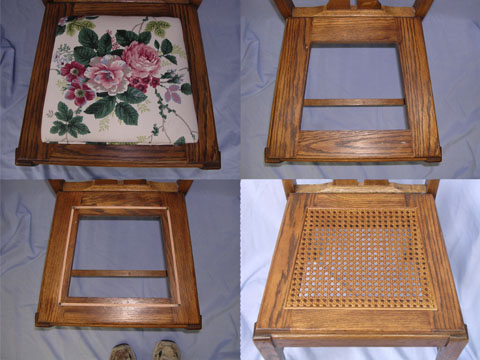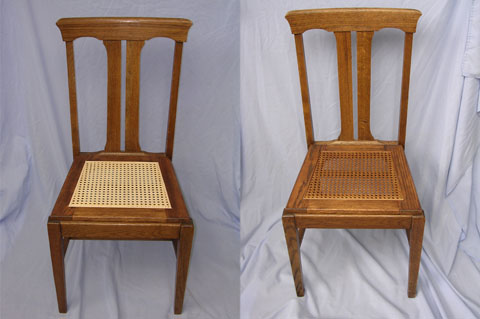How To Repair A Cane Chair
The Chair Dr. Pikestaff, Wicker, Shaker tape, etc.
Splined Cane
This type of cane is actually a pre-woven mat cut to size with the edges held in identify by something that looks like a long slice of wood and is chosen a spline (some telephone call it a splint which is wrong). This installation method is similar to the way screen is held in the screen frame of your habitation'south windows, only a lot more than strong because it's glued in place. The long, smooth looking piece along the edges of the cane mat in the picture in a higher place are the spline. The spline doesn't go all the way through the chair, and so underneath is smooth instead of showing loops and knots similar hand-caning does. This fabric was developed to reduce the labor costs of paw weaving. It is by and large less expensive to supersede in 1 piece like this rather than doing it 1 strand at a time similar the manus-woven type.
Pricing


Hand-woven tin seat
This type of caning is different than splined cane. Each strand is hand-looped through holes drilled through the forest around the edges of the opening and woven through the other strands. In the picture below it is hard to run into the holes considering a slice of flat cane is secured over them to make information technology look ameliorate, but if you look close you can run into a small-scale loop at the location of each hole holding the flat cane all around the edge. Generally you volition see pikestaff looped on the back of the frame (or under for a seat) equally in the second picture beneath through individual holes, which identifies it as hand-woven.
Pricing
Hand-woven cane back (rear view)
Hither you can see a chair dorsum with the cane looped through the holes and around the back of the runway. An unrelated merely interesting side note is that the nail heads y'all can see along the inside of the side runway are for square nails, which they pretty much stopped making effectually the late 1800's.


Converting to splined cane
Making a seat or back conform splined pikestaff can be a touchy process because of the holes already drilled in the perimeter of the opening (if it is hand caned). When a groove is cut through the holes the wood becomes a piffling more unstable (more probable to break). If done properly it is an acceptable alternative to paying for hand caning. The kickoff time it will cost close to the same price that hand caning will cost anyway (because we have to cutting a new groove).
Some people talk almost ruining the 'innate value' of the chair if it is converted from holes to grooves. This is a valid concern if information technology is important to keep the chair similar it is, or if it is a rare piece with some actual value to information technology. Well-nigh furniture, even so, even antiques, is not all that valuable in the first place. The main value is the sentimental attachment.
If the seat frame is all gear up for pikestaff, as in this chair that had an existing seat opening covered by a cushion, it is a somewhat easier procedure than converting from hand-woven to splined. In these pictures the wood frame was already existing. All we had to do was cut the grooves and install the cane fabric and spline. The seat frame was removable, which helped hold downwards the costs as well.
Pricing
Paper fiber blitz seats
Nowadays paper cobweb is more common to meet on rush seats than real blitz (adjacent picture). Newspaper cobweb comes in long rolls and two colors - gilded and dark-brown. It tin can be colored to match your chair, and is a very reasonable replacement for actual rush. Price depends on how modest the diameter of the cobweb. The smaller the string, the longer information technology takes to wrap and the more material is needed. But information technology looks amend. The larger the string the less fabric is used and labor is less. Simple seats like the ane pictured here are around $160.00 or priced by the inch of the longest track (usually the front) and the size of the fiber.


Rush seats
In the olden days (actually not then very long ago for some of us) reeds or blitz fibers were paw-rolled into strings and used as seat or dorsum fabric for chairs. Later, paper fiber (previous picture) was used instead because information technology was stronger and less labor-intensive to brand, and hence less expensive. There are some people who still use real rushes to exercise this, and The Chair Dr. can practise information technology if you lot want, but most of the time it is only as well costly.
Blind caning
A different style of paw-woven caning is blind or French caning, which is usually a style used on the back of a chair, and then you lot can't encounter the loops and knots on the back of the chair back (meet the previous hand caning picture). You can come across in the height two pictures the front holes and the back with no holes. In this manner of caning each strand is cutting to verbal length and pegged in identify. It is a very weak style and so not used very much. Information technology is also nearly twice as expensive equally paw caning. The Chair Doctor of Grand Junction does not do this type of caning. Only we tin can convert it to splined cane, which for the starting time time costs a little more than spline cane that already has a cutting groove for the spline. If you expect shut at the bottom right picture nearly the acme you'll run into the groove we are cutting in this chair dorsum and so we can install splined cane.


Other pikestaff, rattan and wicker
The Chair Doctor has repaired other types of cane wrapping and wicker also. The pictures show a rattan chair with cane wrapping at various points. Top right shows a new wrapping (left) and an existing wrap. Bottom shows the wrap on the right and left arm corners. The pictures show a rattan chair with cane wrapping at various points. Top right shows a new wrapping (left) and an existing wrap. Bottom shows the wrap on the right and left arm corners after we replaced the old wrapping.
Wicker is a blazon of fibrous material and is usually round instead of flat like pikestaff. Unremarkably the whole slice of furniture is done in wicker. Minor wicker repairs can be fabricated if they are not much bigger than about an inch or and so. Broken wicker strands can be re-woven, and various other small-scale repairs can be made. Even so, all-encompassing repairs are pretty expensive, unless yous find a hobbyist who is willing to work for the fun of information technology. By and large, nosotros are besides expensive for a lot of wicker work. Search the spider web and you may exist able to notice some people who are willing to take on this kind of project, or cheque with local charities to run across if there is a grouping who can exercise information technology.
Pricing
Coloring cane to match
Whether splined or hand-woven, cane is usually colored to match the article of furniture end. Since it is a very hard surface it doesn't accept stains well, the all-time way (we feel) to colour it is to mix color in the finish (we utilise lacquer) and spray it on. Some people claim that spraying with lacquer 'seals' the cane and makes information technology breakable, simply this merely isn't true.
In the showtime place the pikestaff material itself is very hard and doesn't 'breath' all that well anyway (at least on the top surface). In the second place lacquer is gas permeable, meaning that oxygen (with moisture in it) will laissez passer through, albeit slowly. Remember growing upwardly when mom would yell at us for not using a coaster under our drink spectacles? That was because if we didn't we'd leave a white ring. This ring was moisture that penetrated the lacquer (or shellac). In the third place the back of the cane is able to absorb moisture better, and is non colored or is very lightly colored only. This service is usually included in repair costs.

How To Repair A Cane Chair,
Source: https://thechairdoctorofgj.com/cane.htm
Posted by: cochrantaidow.blogspot.com


0 Response to "How To Repair A Cane Chair"
Post a Comment